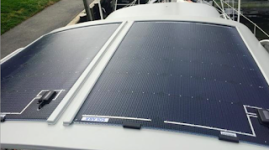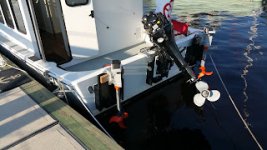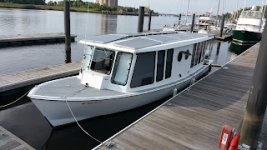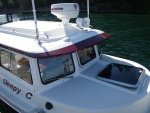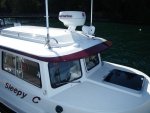In case anyone is interested, I've been using a pair of the lightweight (formerly called "flexible" until they found out that wasn't such a good idea) 100-watt panels for about 1.5 years now. These have provided 100% of my power needs for all this time (RV). They are Grape brand, although I don't think Grape has any of these panels available now.
I originally bought these for the C-Dory, but before I mounted them, I decided to try them out as "ground panels" with my RV. This was for a few reasons: I wanted to see how they would fare, since they are not known for being super long lasting; I wanted to get an idea of how much wattage would be good for my uses (both on boat and RV). So I set up a system with the two panels set out in series (I prop them up slightly to both support them and let them get cooling air underneath); a length of 8AWG cable to the controller (so I could get them at least 25' away without a huge voltage drop penalty -- this is an RV thing so I could park in the shade but put panels in the sun); a Sunsaver 15 MPPT controller, a foot of 2AWG cable, and then my AGM battery bank. I have both a Victron amp counter type meter plus a Smart Gauge, and also a remote display for the Sunsaver -- so I can keep pretty good track of how things are going.
I'm fairly "low maintenance" when it comes to loads. My biggest/constant draw is a Dometic CF-50 portable refrigerator. That draws about 3-1/2 amps when running, and it has been using between ~15-30 amp hours per day depending on ambient temps (have been in some really hot weather at times). My other draws are laptop, phone, and AA battery charging, LED lights, and a few other minor items. I had figured on 48 amp hours per 14 hour day, but have been using less than that in actual use. It varies of course, but perhaps you could say around 30-35 amp hours on average.
For this amount of usage I haven't had any problems keeping my battery bank charged. Most days see it back up to 100% while still leaving me some "free sun" with which to charge things or do whatever. I probably haven't had more than three or so cloudy days (or days when the panels weren't out at all due to some other factor), and I have almost always still been able to get up to 100% on the next sunny day. I think one time it took part of the next day (i.e. the sun set and the batteries were not up to 100%).
Of course this wouldn't be the same if I were someplace like the Inside Passage with mostly cloudy days. But perhaps it gives some useful info.
On the lightweight/"flexible" panels themselves. I wouldn't buy them unless I "had to." I knew that going in though. The reason I say that is that I really baby them (carefully support them when out in the sun, provide ventilation for the underside when in use, clean them with lots of water so as to avoid scratching, and put them back in their boxes for transport) and they are still looking a lot more "worn" than traditional panels would be. They do still both work*, but there is some cupping of the plastic on top of the cells, and one of them has some pits through the top plastic layer. I wouldn't expect them to last the 20 years of traditional (glass/aluminum) panels.
On the other hand, they are less than 1/4" thick and weigh three pounds apiece. For taking in and out of the RV as ground panels (and storing them upright behind the driver's seat), they are unbeatable.
I always did intend to put traditional panels on the RV roof, and I won't change that plan. Although 200 watts is fine for my use, I don't want to just have ground panels. Reason is that they can't be in use when I'm driving, nor at certain overnight stops (Walmart, etc.). And if I were parked in the sun anyway (say there's no shade), then no need to even fuss with the ground panels.
I had intended to put these panels on the roof of the boat, but after using them as ground panels I changed my mind. I like the looks of some of the "better" lightweight panels (Solbian, Aurinco), but they are pretty expensive and I think may not have come in the "right" physical size anyway (been awhile since I shopped them though).
So I decided to put some of the "efficient" 100 watt traditional glass/aluminum panels on the boat. The reason I say efficient, is that there is one panel that is able to make the same specs with only 32 cells (vs. 36) so instead of being something like 22" x 47" they are 22" x 41". A pair of those fit on the C-dory better (leaving room for a radome or etc.). They are also only 15 pounds apiece (not nearly as light as the plastic panels, but lighter than some of the larger/heavier traditional panels).
I mounted them across the handrails of the 22, with the two panels running fore-and-aft. This allowed me to use the panels themselves as "rails" of a sort. I joined the panels together with lengths of aluminum angle, then used some bimini fittings at the four corners. I combined some inspiration by EZ DUZIT's installation and then added my own tweaks (mine are flat; his are a gable shape).
I imagine that before too much time passes, we'll all be able to have relatively economical, thin, lightweight, super durable panels. At least I hope so!
Sunbeam
*I did have a failure of one of the lightweight panels. I noticed I wasn't taking in the usual number of amps, but was fooled at first because the voltage was correct (around 33.x volts since I have the two in series). However the amperage was not right. Aha. Then I looked at the diode box on one of the panels (where the wires connect to the panel - is on top of the panel on these thinner panels vs. on the back on traditional panels) and it was totally melted. Tends to make them not work! I had that replaced under warranty (thankfully Grape had held some back when they quit selling them for just that reason).
